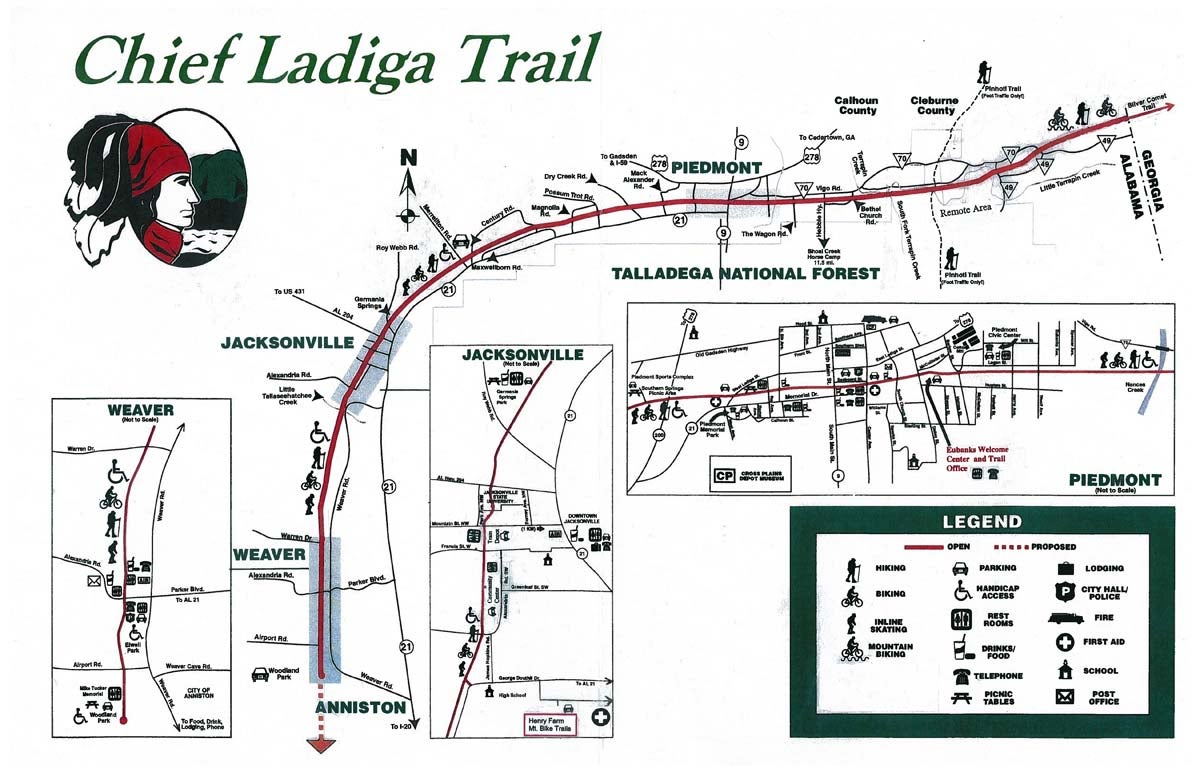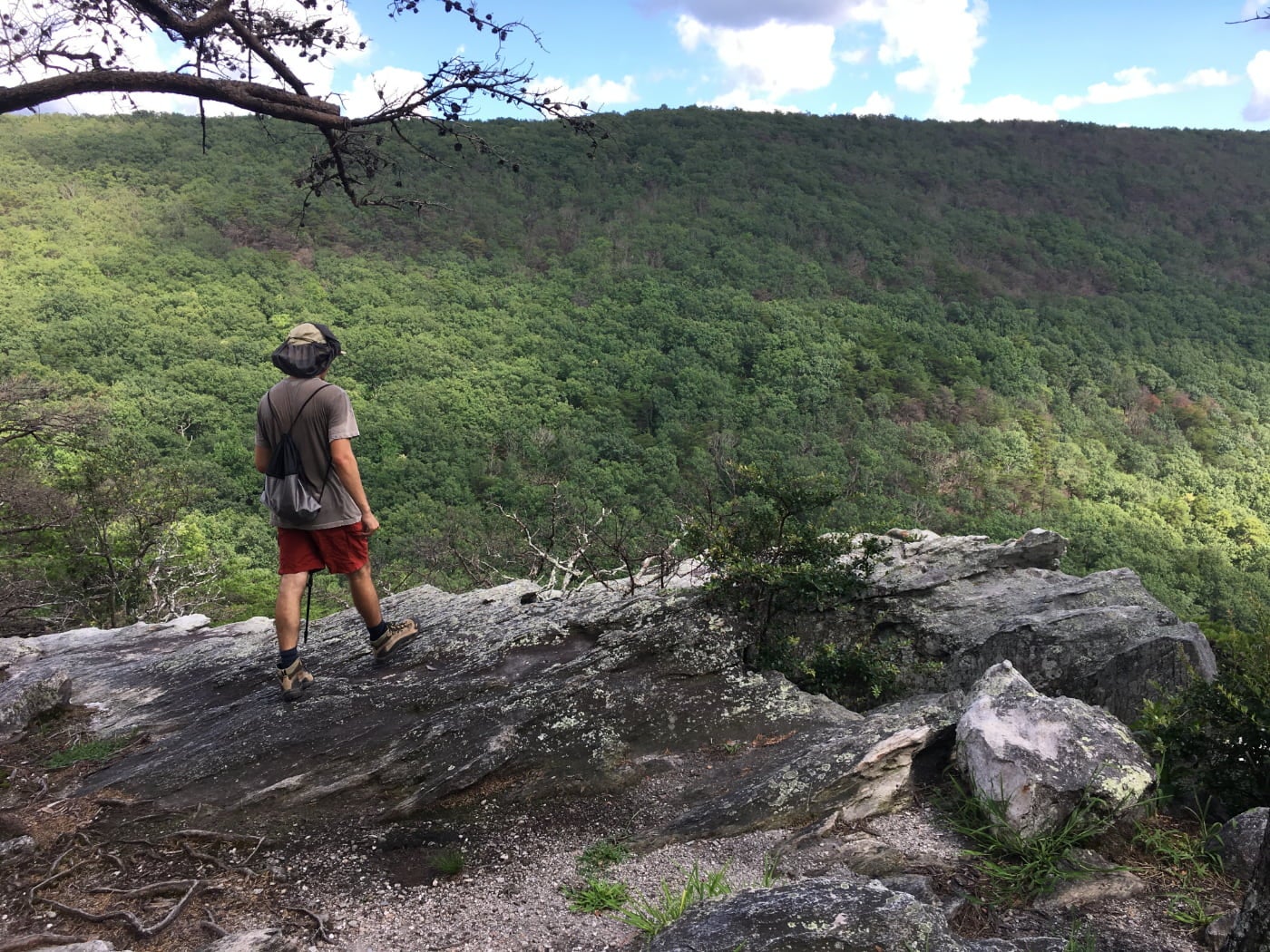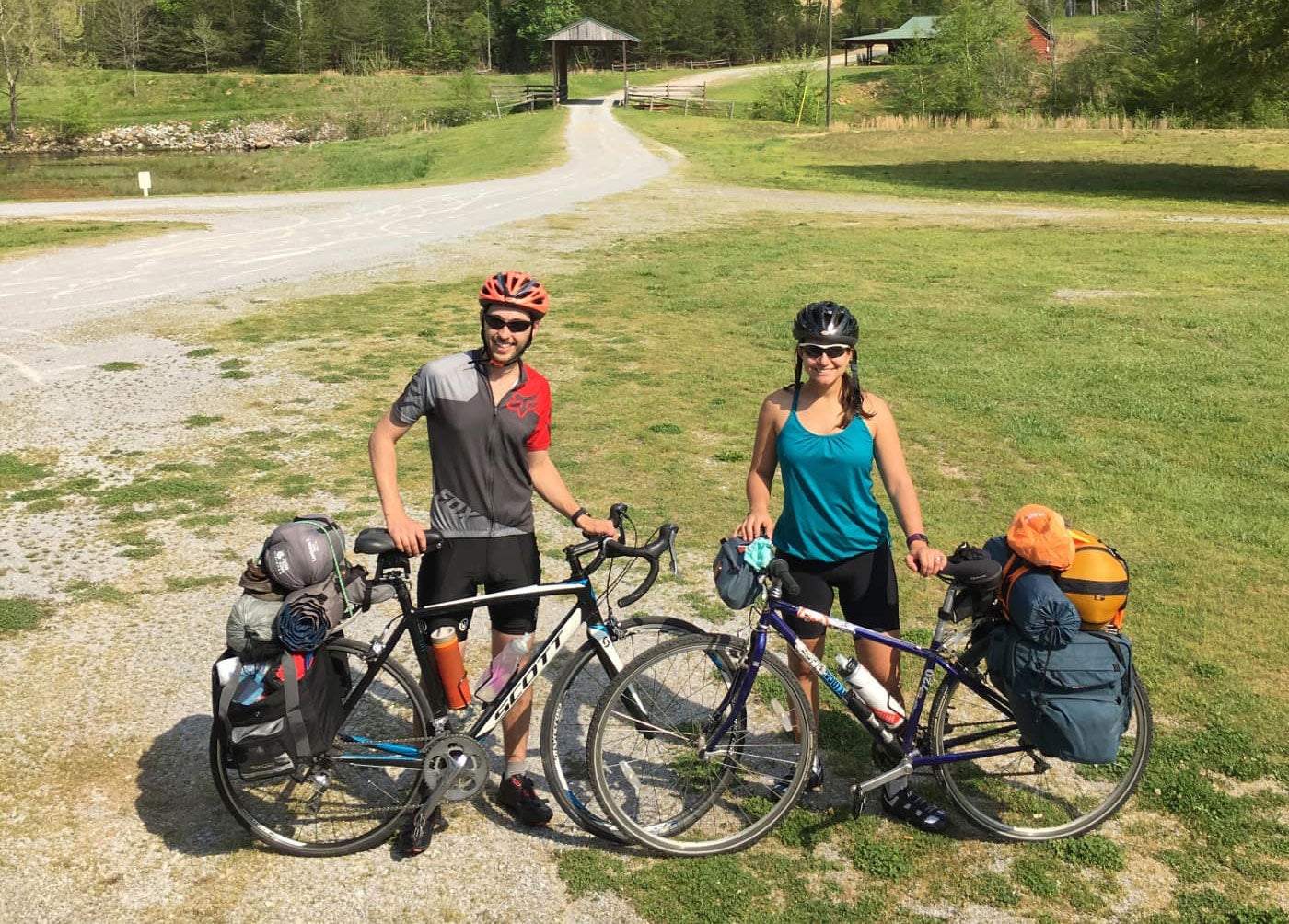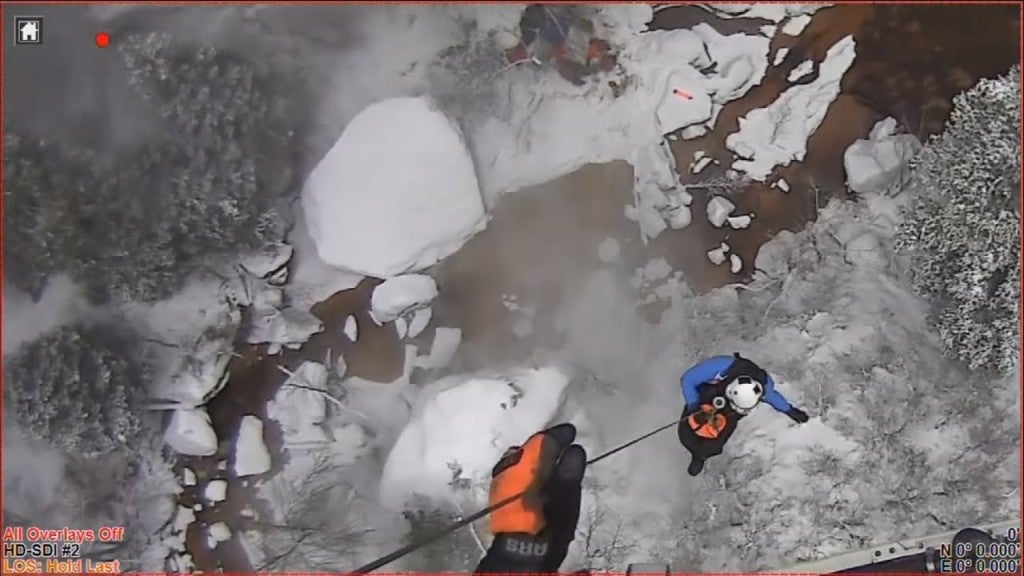This article was brought to you by Renogy, the makers of solar phone chargers that help you stay connected even when you are miles from the nearest power outlet. Water-resistant, shock-resistant, and dust-proof, their gear is designed with the outdoors in mind.
Tucked into the trailing foothills of the Appalachian Mountains, in Alabama’s narrow swath of Piedmont hill country, lies the 33-mile Chief Ladiga Trail. This paved, graded slice of Alabama not only makes for fantastic bikepacking and bicycle touring, but will also carry you through the southeast’s rich history.
As you pedal from the Alabama-Georgia state line west to the town of Anniston, you can view the unique geography that shaped this part of the world. The Chief Ladiga Trail passes into the Talladega National Forest as the southernmost tip of the Appalachians rise in the distance. It continues through trestle bridges, wetlands, and the rolling grasslands of the Alabama low country.
The Chief Ladiga Trail is Alabama’s first ever rail-to-trail conversion, made up of the state’s section of a former CSX railroad corridor. When you count the Georgia segment that runs from the state line to Smyrna, that old corridor adds up to the second longest paved trail in the country. Along the way, there are several stops where you can stretch your legs, get a bite to eat, experience classic Southern hospitality— and, of course, camp out.
Bicycle Touring Along the Chief Ladiga Trail
The wonderful thing about bicycle touring on rails-to-trails conversions is that you are guaranteed a fairly level grade and slow, steady elevation gains, if any. That makes these trails especially accessible for newcomers to bicycle touring, and it means you won’t have to worry quite so much about packing ultra-light. That’s especially true given how many opportunities you’ll have to purchase food, beverages, and gear along this relatively short, well-connected trail.
What you should emphasize on your gear list is making sure you have plenty of water and moisture-wicking clothing to withstand the sticky Southern spring and summer season. Or, if you’re tackling the Chief Ladiga Trail in the fall, wear lightweight layers to help manage the warm days and cool nights. At any time of year, sunscreen and bug spray are wise items to pack, as is a well-ventilated rain jacket and fly for your tent, hammock, or backpack.
A solar phone charger is a lightweight way to keep your electronics charged on the go without taking up too much room in your panniers, too. That way you can stay in contact with people back home, look up weather information, double check your maps, and snap photos of the scenery along the way.
The History of the Chief Ladiga Trail

Image from Annistonal.gov
The South has few active rail lines these days, outside of Amtrak’s Crescent and Silver Service. But at the turn of the last century, all sorts of freight and passenger routes had blossomed across the southeast after the Civil War. Some, called the Juice Trains, carried tourists from the northeast to newly developed tourist attractions in Florida. Others were built to haul timber out of the rich stands in North Carolina, Georgia, and Alabama. And others were simply a convenient way to get between small, rural towns via the kind of hometown sidings remembered in books and movies like Fried Green Tomatoes at the Whistle Stop Cafe.
One of these rail lines was the Seaboard Air Line (SAL), a crucial route connecting Raleigh, North Carolina to Birmingham, Alabama via Atlanta, Georgia. The name didn’t refer to airplanes, of course—this was the late 1800s. Instead, “air line” was a phrase that meant something akin to “as the crow flies,” suggesting the fastest possible route between two points. As train traffic dwindled in the mid-century, however, the once-famous Seaboard Air Line was bought out by CSX. By the late 1980s, CSX had shuttered the section of the old SAL track that ran through Georgia and Alabama.
In the early 1990s, the rails to trails movement reached the southeast and the graded track was paved and converted for pedestrians, cyclists, and outdoor enthusiasts to enjoy. While the Georgia section was named the Silver Comet trail after the train that used to run that route, the Alabama section was named the Chief Ladiga Trail. The intention was to honor he last Muscogee chief in the region before the tribe was forced to give up its lands during Andrew Jackson’s campaign of Indian removal.
Start at The Eastern Terminus of the Chief Ladiga Trail: the Georgia/Alabama State Line
Esom Hill, Georgia was founded in 1848— just a few decades before the trainline came through. Today it sits close to the Georgia/Alabama border that divides the Silver Comet Trail from the Chief Ladiga Trail. You can officially kick off your bikepacking trip at the State Line Gateway Park. Here you can check that your panniers are loaded properly and snap an inaugural photo before you start your trek.
Just 7.5 miles later, you’ll reach the Chief Ladiga Trail Campground, surrounded by the gorgeous Talladega National Forest. If you’re pedaling on a hot day— and let’s face it, this is the south— you might appreciate the opportunity to cool off in a small stream just off the campground. This campground also connects with the Pinhoti Trail, a 335-mile thru-hike that extends from Flagg Mountain, near Weogufka, Alabama to Blue Ridge, Georgia.
Continue through Piedmont, Alabama

Image from The Dyrt camper Ethan K.
Seven miles later, you’ll pedal past views of Dugger Mountain (the second highest peak in Alabama) to reach Piedmont, Alabama. This tiny town, once sustained by the local textile mill, is the birthplace of Pulitzer Prize-winning journalist Rick Bragg. The Prince of Frogtown, Bragg’s biography of his father’s upbringing in East Alabama, could be an interesting read to bring along so you can become even more immersed in your surroundings.
Despite its small size, Piedmont has several shops where you can purchase any outdoor gear you forgot or need to restock. The aptly-named Chief Ladiga Trading Post specializes in firearms and ammo, while the Terrapin Outdoor Center carries canoes, kayaks, stand up paddle-boards, PFDs, and other water sports gear. If you have time, you can easily build a little paddling adventure on the nearby Terrapin Creek into your bike tour. Terrapin Outdoor also carries climbing equipment, in case you want to make a detour to the crags at Cherokee Rock Village, Sand Rock Alabama, or Cheaha State Park.
Grab a Bite in Jacksonville, Alabama

Image from The Dyrt camper Asher K.
Another 12 miles will carry you in a curve around Dugger Mountain to Jacksonville, Alabama. This college town is home to Jacksonville State University, and you can definitely find a burger, some barbecue, or some cajun fixin’s if you’re hungry after days of bikepacking. You can also learn more about the Chief Ladiga Trail’s namesake here. Jacksonville was founded after the Creek and Muscogee tribes were forced to give up their lands following the signing of the Cusseta Treaty in 1832. Chief Ladiga had retained some of his privately held lands after signing the treaty, but sold a portion a few years later. That second parcel is where Jacksonville now stands.
There’s quite a bit to do in Jacksonville, if you feel like stopping. For one, you can check out the original Rail Depot where the Seaboard Air Line once stopped. It was originally built in 1860, but wasn’t used for eight years because of the Civil War. In 2010, the city renovated it for use as a community space. You can also bike eight miles away from the Chief Ladiga Trail to check out Choccolocco Mountain, where there are hiking and mountain biking trails in addition to ATV trails and other spaces for off-roading. Additional popular choices for cyclists are the Henry Farm Mountain Bike & Running Trails, also known as Germania Springs Park.
Marvel at Changing Landscapes near Weaver, Alabama

Image from The Dyrt camper Asher K.
Next up is Weaver, Alabama, just six more miles down the trail. Here you can see how the foothills of the Appalachians in which you started the Chief Ladiga Trail have given way to stands of pines and low-lying wetlands. As North America and Africa broke apart from the supercontinent Pangea millions of years ago, the resulting tectonic activity shaped the Appalachian range and created the Piedmont plateau.
The Piedmont stretches from North Carolina through Georgia and into Alabama, following the curve of the Appalachians. The Piedmont was formed when sediment ran off the Appalachian mountains and caught on lower escarpments over the centuries, before flowing into the lowcountry closer to the Gulf and Atlantic.
Many of the biggest cities in the southeast sit along the furthermost edges of the Piedmont, elevated from the floodplains around rivers and the coast, but not as isolated and inaccessible as the higher mountain hollers. The Chief Ladiga Trail naturally follows that geologic contour by virtue of once having been a railroad connecting all those Piedmont cities.
Finish Your Journey at The Western Terminus of the Chief Ladiga Trail: Anniston, Alabama
As you pedal from Weaver to your final stop in Anniston, Alabama, you’ll see a rare stand of old growth pines in the distance at Mountain Longleaf National Wildlife Refuge. The pines aren’t the only unique flora and fauna there, however. The Mountain Longleaf Refuge is also home to the white fringeless orchid, common juniper, grey bats, and 68 species of migratory birds including Easter Meadowlark, Eastern Bluebird, Northern Bobwhite and Mourning Doves. You can also take in views of the surrounding countryside from Moorman Mountain Rock Ledges, one of the higher points in the area.
Once you reach Anniston, toast your big accomplishment at Cheaha Brewing Company. They craft their beer list on-site and serve up a generous menu of pub food and Southern favorites. If you want to learn more about the natural history and geology you saw along the Chief Ladiga Trail, hit up the Anniston Museum of Natural History. The Alabama: Sand to Cedars exhibit in particular will give you an up-close view of the state’s marine and terrestrial life. The Longleaf Botanical Gardens are a stunning destination, too, with exhibits not only on local pollinators but also on the effects of climate change as far away as Antarctica.
If you’re looking to camp at the start or finish of your Chief Ladiga Trail ride, bunk down at Michael Tucker Memorial Park. It’s a pretty small campground run by the city with a gazebo, a drinking fountain, 16-site primitive campground, and restrooms. Right off the trail, however, the convenience is hard to beat.
You’re in Luck! Anniston, Alabama Has Become a Bike Touring Destination

Image from 2017 Coldwater Mountain Enduro 3rdcoastproductions.com
If you need to fix up your bike, whether upon completing the trail or before heading out for a West-to-East ride, visit Wig’s Wheels. They sell bikes and cycling gear and offer bicycle service and daily rentals. They can also recommend the best trails to check out at Coldwater Trails, which is less than 3 miles from the shop and has over 35 miles of mountain bike trails.
The folks at Wiggs can even clue you in to the many cycling-related happenings in Anniston, which has become a destination for two-wheeled enthusiasts. In addition to the Chief Ladiga Trail, the area has hosted the Alabama Classic Road Race, 3rd Coast Enduro Mountain Bike Race at Coldwater Mountain, Iron Mountain Challenge Century Ride, the Black Squirrel Mountain Bike Series, and the Cheaha Challenge Century/Ultra Cruise.
That’s on top of community-scale events spearheaded by Wig’s like their weekly Beers and Gears mountain bike ride. Between those events and races and the recent expansion or establishment of bicycle touring trails in the southeast, it’s no wonder that cities in Alabama, Tennessee, and Georgia have become southern mountain biking meccas over the past decade. The success of the Chief Ladiga Trail in bringing bike touring and bikepacking enthusiasts to Alabama’s Piedmont over the past thirty years, and the growth of the outdoor industry at large, hint at even more good things ahead.
Related Campgrounds:
- Gulf State Park Campground, Gulf Shores, Alabama
- Dauphin Island RV Park & Campground, Dauphin Island, AL
- Island Retreat RV Park, Gulf Shores, AL
- Lake Eufaula Campground, Eufaula, AL
- Auburn RV Park at Leisure Time Campground, Auburn, AL
- Honeycomb Campground, Lake Guntersville, AL
- Wind Creek State Park, Alexander City, AL
- Desoto State Park, Fort Payne, AL
- Cheaha State Park, Delta, AL
- Alabama Coast Campground, Foley, AL
- Oak Mountain State Park, Pelham, AL
Popular Articles:
Articles on The Dyrt Magazine may contain links to affiliate websites. The Dyrt receives an affiliate commission for any purchases made by using such links at no additional cost to you the consumer.



